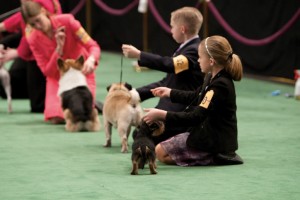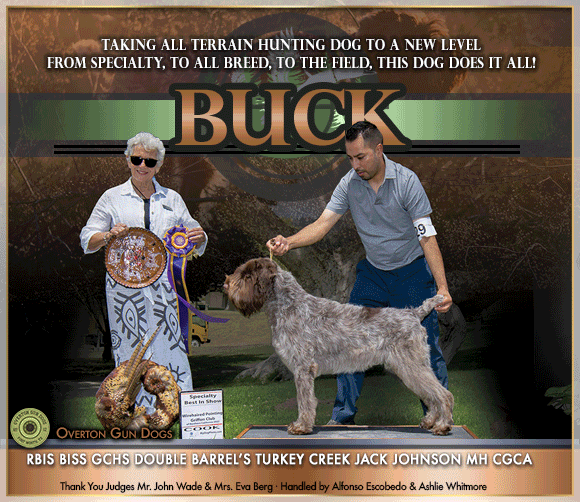From The CC Vault: Wake Up and Smell the Lack of Attention
by Dr. Bob G. Smith
Originally published: February 2010
Photos by Lisa Croft-Elliott
May I have your attention, please? Stop and pay attention! Quit that and pay attention! You’re not paying attention! How many times have we either uttered those phrases or heard them being uttered by others, especially by announcers, parents and teachers? Why do we have to constantly remind people to pay attention, especially at dog shows? It probably has to do with the visual and auditory stimulation that surrounds us even before we begin our judging, showing, or viewing.
The more I judge, the more I become aware of how much time is lost waiting on exhibitors to “wake up and smell the coffee”; that is, wake up! Because exhibitors indirectly pay the fees requested by judges, I am not going to be accused of “biting the hand that feeds me.” However, it appears to me that there are some exhibitors who impede the smooth operation of the judging process in a day’s time by their lack of attention to the judging process and/or their tardiness to the ring.
Of course, show sponsoring clubs depend on the revenue from exhibitors’ entry fees in order to host a show. Certainly, exhibitors are the special ingredient that makes a show go! As a former local and national club show chairman, I personally know how financially insecure that can be. However, it appears to me that some exhibitors feel that because they pay their entry fee(s) that their tardiness to the ring is their privilege. And, for the most part, judges and stewards tolerate this behavior. I guess it is out of the goodness of judges’ hearts that we do wait. (Many of you think we don’t have a heart; but we do!) In spite of that, most of us wait.
The AKC policy/rules governing show operations found in each premium list and judging program states: judges are not required to wait for exhibitors. Often judges wait while an exhibitor exchanges one dog for another one. Understandable? YES. Until the exhibitor who has 9.5 dogs in crates nearby can’t remember which dog is in which class, forgets the dog’s numbered arm band, and hands off the wrong dog to a friend/enemy/acquaintance/total stranger. What’s the 9.5, you may ask? The .5 is a dog that is often half-way in and half-way out of the crate…inquisitive and damn sure it’s not going to miss anything. The exhibitor has to physically wrestle him/her back in the crate while trying to balance “sir lunge-a-lot’ on one hip, while extracting “madam missed again” from her castle! Cute? Yes, if you’re watching AFV and it’s Pet Night. Not so, when a judge is waiting patiently in the ring to begin judging the next class. I accept that there are no restrictions on the number of dogs that can be entered by one exhibitor and firmly believe that is the way it should be. The “more, the merrier” is the mantra of most dog show giving clubs and so be it! I see nothing wrong with entering multiple dogs in every class in every breed! As a judge I only ask that some thought be given to who is going to assist the handler at ringside, moving dogs back and forth from their crates before exhibiting and after they have won or lost. What usually happens with multiple entry-handlers, the handler picks up the dog that has just been shown, hurries back to the setup to retrieve the next dog, secures it or the wrong one and returns to the ring a few minutes later, ready for the next class. Anything wrong with this picture? The reader has already figured it out.
I want to make sure that most professional handlers with partners, assistants, “gofers” and staff are not included in the above scenario! Also not included are the bred-by and owner-handlers who are always prepared and “at the ready” at ringside. Were it not for most professionals and other attentive handlers, some shows would slow down to a crawl. Most professionals have the next dog at the ring, the majority of the time, with someone else handling it, until the appropriate handler arrives, usually dashing around the outside of one ring to another. It is their livelihood; they are paid to be on time and ready. They do not keep clients very long if they consistently miss ring times.
If any of the above situations strike a chord in the reader’s heart, mind, soul, or body as applying to you, GOOD for you. Next time maybe the judge will be more patient and maybe the exhibitor will be better organized with appropriate help, etc.
Getting to the ring quickly and appropriately prepared are different situations; once inside the ring is something else. Recently I judged Junior Showmanship classes and was delighted to have bright, intense, skilled and attentive youngsters in my ring. They listened, followed directions and responded appropriately. It was a hard day judging their classes! Why? They were all excellent! They knew what to do. They watched the ring patterns of the other juniors so that when it came time to move their dogs, they were ready and went the right way, stopped where I directed them, and returned to the appointed spot. Made my job as a Juniors Judge that much harder, but much more enjoyable than some of my breed ring judging.
What? Huh? Me? Did you say “Down and Back?” Once in the ring, “Tardy Turk” is quite busy getting the arm band adjusted from upside down to semi straight while waiting to exhibit his entry. Why is it that some exhibitors hang on a judge’s every word, absorbing whatever positive movement, nod, nuance related to their dog? And others, even while looking a judge directly in the eye, cannot understand “Down and back?” Several judges, with whom I spoke during the research phase of this article, spoke of giving the direction: “Small circle please and back to me”. You know the old story. The inattentive handler took the judge’s direction literally. The handler took a few steps around in a “small circle” in front of the judge and stopped. Some of you may think this is one of those “Urban Legends” that has a life of its own! Not true! It is true! Has happened to me in my short tenure of judging; and the handler was not a Junior! For some exhibitors are in their own world–some wander about the ring in whatever fashion, creating their own pattern of movement. It’s difficult to adequately judge a dog under the best conditions let alone when the exhibitors fail to follow the simplest of directions!
“Pay attention and follow simple directions” are two requests I have as a judge when in my ring. I hope that’s not too much to ask of exhibitors. There really are reasons behind the requests given by judges to exhibitors. All the patterns requested are done so in order for the judge to get the best view of the dog no matter in which direction it is going. There are few surprise patterns any more used by judges, except maybe the results can be surprising to an exhibitor who didn’t present his/her dog in an appropriate way.
I do not think that it is too much to ask that an exhibitor be ready at the ring at the assigned time AND be prepared. Most clubs will allow crates for small dogs near ringside during the breed judging. The breakdown seems to occur when no one is there to assist with the switching of dogs or having the next dog at ringside ready to be shown. Two people can handle this situation smoothly: one exhibitor and one ringside assistant/friend/stranger/child/husband/mother/neighbor.
If this treatise seems harsh to the reader, no apology is given. What has been written is based on experience in the ring and listening to judges discuss occurrences in the ring. With fewer judges being used and with many judges assigned near the maximum of breeds, the loss of 5 minutes per breed judged because of having to wait on exhibitors creates a longer than necessary day for exhibitor, dog, AND judge.
Attention to details by clubs and members… show chairmen and hospitality committee members
Some additional attention to detail by show chairmen is encouraged. Most show chairmen are “on the ball”, prompt, and have great planning and management skills. Some are new and are “changing the flat tire as the car is careening down the hill.” Nevertheless, when employees (JUDGES) are hired, the more information that can be given to them ahead of the show date, the BETTER job the judges can do while getting to the show site.
One suggestion is to assure that map and directions to the show site are included in any correspondence from the club correspondent; information about transportation including name of and times for pickup, making sure transportation to and from show site is confirmed in correspondence before show –?is a shuttle being provided by the hotel; are club members driving judges? What time will the judges be picked up at the hotel? Judges usually do not need to arrive at the show site earlier than 30 minutes. Some clubs have picked up judges almost two hours before judging begins and judges have had to sit and wait for over 1.5 hours to begin judging. Also for judges who are driving, directions to and from show site for driving. There can never be too much information provided to judges by the show-giving club! The more info, the happier the judges.
I would like to talk about attention paid to food for the judges and stewards. For me, as I am not speaking for any other judge: light fare, appropriate for season (warm food in cool/cold weather; cool food in warmer weather). If a club asks judges ahead of time what drinks the judge would like at ringside, the hospitality chair should assure that the drink request is met at every ring where the judge judges. Many judges do a “walk-about” throughout the day at the wishes of the superintendent or show chair.
I am aware that many times the judging is delayed while stewards or exhibitors search for paper towels and/or sanitizers when a dog soils the ring. Even if there are clean up crews at the show, there are delays because the crew may be working in another ring. It behooves the show-giving club to have paper towels and spray sanitizers at the stewards’ table to assist the exhibitor/steward/spectator in cleaning the ring in a timely fashion in order for judging to continue. Some attention to the detail of having adequate paper towels at ringside assists in the orderly conduct of the judging process. As an aside: please have more than one roll of paper towels as many exhibitors ask for towels to clean up after their entries while waiting for their time in the ring.
The following are a few more “details” with which I would like to end this “attention” piece:…fruit in baskets that won’t spoil…hotels with restaurants that are open for breakfast, lunch and dinner…carts “at the ready” for transporting judges from one ring to another when it involves a long distance or time, especially at outdoor shows…work with superintendents to avoid having one judge move from one ring to several others throughout the day. A better process of scheduling could eliminate such a problem…having stewards who are already trained and attentive to their jobs and do not engage judges in lengthy discussions nor constantly converse with handlers, exhibitors, etc. Their responsibility is TO the Judge and making the judging process go smoothly.
Short URL: https://caninechronicle.com/?p=246838
Comments are closed












